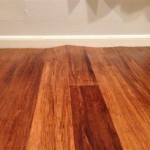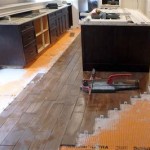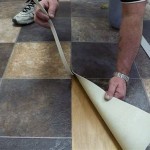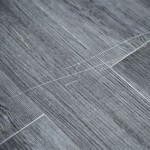How To Remove Deep Scuff Marks From Vinyl Flooring
Vinyl flooring offers durability and aesthetic appeal, making it a popular choice for many homes and businesses. However, its resilience doesn't make it entirely immune to damage, particularly scuff marks. These unsightly blemishes, often resulting from friction with furniture, shoes, or other objects, can detract from the floor's appearance. While superficial scuffs are easily addressed, deeper marks require more specialized treatment.
This article outlines effective methods for removing deep scuff marks from vinyl flooring, restoring its original luster. The techniques described range from simple household remedies to more intensive approaches involving specialized cleaning products.
Before attempting any cleaning method, it's crucial to identify the type of vinyl flooring. Sheet vinyl, luxury vinyl plank (LVP), and vinyl composite tile (VCT) each have unique characteristics and may react differently to various cleaning agents. Checking the manufacturer's recommendations for cleaning and maintenance is always advisable.
Cleaning with Baking Soda and Water: A gentle yet effective method for tackling scuff marks involves creating a paste of baking soda and water. The slightly abrasive nature of baking soda helps lift the scuff without damaging the vinyl's surface. Mix a small amount of baking soda with water to form a thick paste. Apply the paste directly to the scuff mark and gently rub it in using a soft cloth or sponge. Avoid using abrasive materials like steel wool, which can scratch the vinyl. After rubbing, rinse the area thoroughly with clean water and dry with a soft towel.
Using WD-40: WD-40, a multi-purpose lubricant, can also be effective in removing stubborn scuff marks. Spray a small amount of WD-40 directly onto the affected area. Let it sit for a few minutes to penetrate the scuff. Gently wipe the area with a soft cloth, working in a circular motion. Once the scuff is removed, clean the area with a mild detergent and water to remove any residue left by the WD-40.
Applying a Vinyl Floor Cleaner: Commercially available vinyl floor cleaners are formulated specifically to clean and protect vinyl flooring. These cleaners often contain ingredients that can dissolve and lift stubborn scuffs. Follow the manufacturer's instructions carefully when using these products. Typically, the cleaner is applied directly to the scuff mark and allowed to dwell for a specified period. Then, the area is gently scrubbed with a soft brush or sponge and rinsed with clean water.
Utilizing a Magic Eraser: Melamine foam erasers, often referred to as "magic erasers," can be effective in removing various marks from surfaces, including vinyl flooring. Dampen the magic eraser slightly and gently rub it over the scuff mark. The micro-abrasive action of the melamine foam helps lift the scuff without scratching the vinyl. It's important to test the magic eraser on an inconspicuous area of the flooring first to ensure it doesn't damage the finish.
Employing a Vinyl Floor Stripper: For deeply ingrained scuffs, a vinyl floor stripper may be necessary. These strippers are designed to remove the top layer of wax or finish, taking the scuff mark with it. This method is more aggressive and should be used as a last resort. Follow the manufacturer's instructions carefully as improper use can damage the vinyl. After stripping the floor, a new layer of wax or finish should be applied to protect the vinyl and restore its shine.
Rubbing Alcohol Application: Isopropyl alcohol can also be helpful in removing stubborn scuff marks. Apply a small amount of rubbing alcohol to a cotton ball and gently dab it onto the scuff. Avoid rubbing vigorously, as this can damage the vinyl. Let the alcohol sit for a few minutes, then wipe the area clean with a damp cloth. This method is best suited for lighter scuffs and may not be effective on deep or ingrained marks.
Prevention of Scuff Marks: Preventing scuff marks is often easier than removing them. Placing felt pads or glides under furniture legs can significantly reduce the risk of scuffing. Regular sweeping and mopping can prevent dirt and debris from accumulating, which can contribute to scuffing. Using a walk-off mat at entrances can help trap dirt and grit before they reach the vinyl flooring. Avoiding dragging heavy objects across the floor can also minimize the likelihood of scuff marks.
Maintaining Vinyl Flooring: Regular maintenance is key to keeping vinyl flooring looking its best. Sweeping or vacuuming regularly removes loose dirt and debris. Mopping with a damp mop and a pH-neutral cleaner removes more stubborn dirt and grime. Avoid using abrasive cleaners or scouring pads, as these can scratch the vinyl. Applying a vinyl floor polish or wax periodically can provide an extra layer of protection and enhance the floor's shine.

How To Remove Scratches On Vinyl Flooring Singapore

How To Fix Scratches On Luxury Vinyl Floors

How To Fix Scratches On Luxury Vinyl Plank Flooring Steps

How To Remove Scuff Marks From Vinyl Flooring

How To Remove Scuff Marks From Floor Maid Sailors

How To Fix Deep Scratches On Vinyl Flooring Planks

How To Remove Scuff Marks From Your Floor Maggy Maid

How To Fix Scratches On Laminate Flooring Directflooring Direct

How To Clean Vinyl Flooring Drag Marks Stains Scuff Cleaning Guide King Of Floors

8 Ways To Fix Scratches On A Laminate Floor Mersey Flooring
Related Posts








